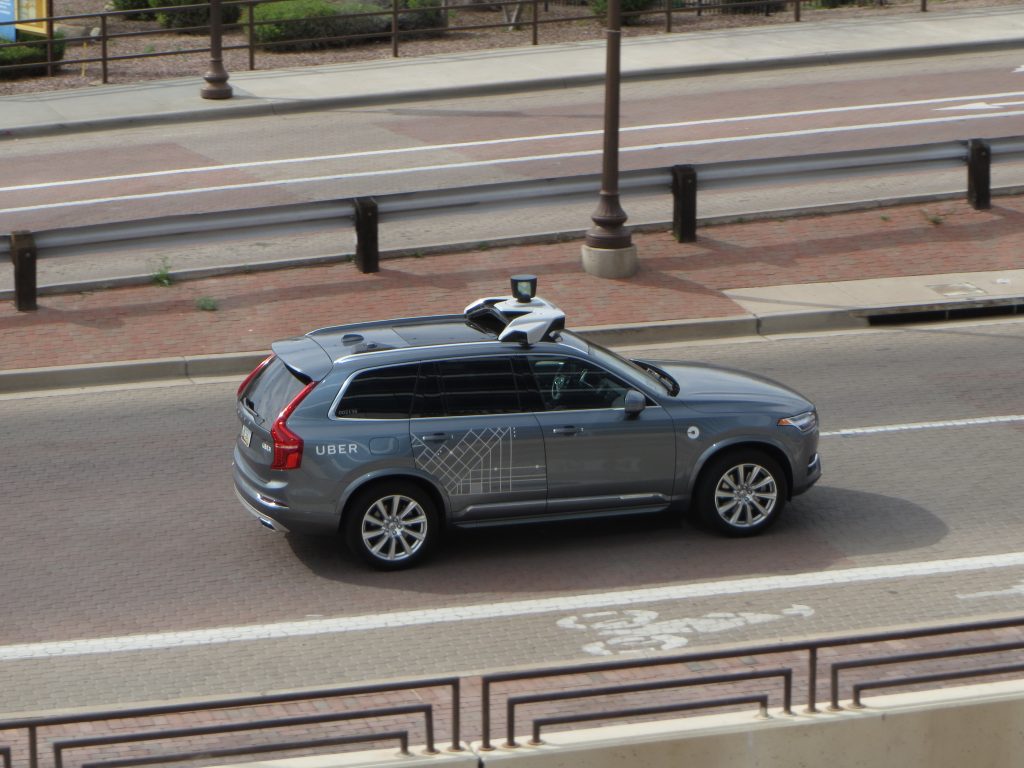The House takes its first crack at automated vehicle legislation
As self-driving technology advances toward becoming an everyday fixture in our lives, Congress is beginning to consider regulations to govern how they’ll be tested, how they’ll operate and how to ensure they’ll be safe for everyone. But are they taking the right approach?

Uber’s self-driving pilot program in Pittsburgh. Flickr photo by zombieite.
The House Subcommittee on Digital Commerce and Consumer Protection last week produced what they hope becomes the first federal law on automated vehicle testing and regulation, combining 14 bills that were introduced after a hearing in late June into one bill.
Legislators have been under tremendous pressure from the private sector (like automakers, for example), who say that legislation is necessary to increase safety, avoid a patchwork of state regulations and streamline, not stifle, innovation. While cities are generally both supportive and convinced of the long-term benefits that self-driving technologies could offer, many cities are also concerned by this rush to legislate without their input, potentially losing the ability to regulate their own roads, the lack of data provided by the private sector, the short-term threat to safety, and a lack of focus on long-term impacts to equity, the environment, congestion, land-use and a host of other critical issues.
What’s in the bill?
Among other things, the draft bill contained provisions that would:
- Pre-empt cities and states from regulating the “design, construction, mechanical systems, hardware and software systems, or communications systems” of highly automated vehicles.
- Allow automakers to self-certify the safety of both the vehicle and its software without an independent reviewer.
- Increase the number of NHTSA exemptions to test automated vehicles on public roads from 2,500 to 100,000 vehicles per manufacturer.
- Create an advisory council that would be devoid of any representation from cities, MPOs or states to study and advise on the effects of this technology.
- Allow manufacturers and operators to keep secret “…situational information related to any testing or deployment event.”
What are our concerns?
While the bill addressed some of the most critical issues, much of the language lacked specificity and failed to consider the needs of local communities or the long-term impacts of this technology.
Members of our Smart Cities Collaborative were concerned. So last week, we partnered with the National Association of City Transportation Officials (NACTO), National League of Cities (NLC), Natural Resources Defense Council (NRDC) and other organizations to oppose the legislation as it was introduced.
We traveled to Capitol Hill to share our concerns directly with members of the committee and offer alternative language and amendments. Here are some of the specific changes we were seeking:
- Clarify pre-emption language in order to guarantee that local communities will retain control of their streets.
- Reduce the number of possible exemptions from 100,000 to a figure that cities and states can safely manage on their streets. We suggested 5,000 was a reasonable increase.
- Require that the advisory council contain representatives from local governments (including states, MPOs and urban and rural communities) to participate in the conversation alongside the private sector.
- Establish a third-party repository of data that’s accessible to cities, states, academics and safety advocates on the operational and safety performance of any automated vehicle granted a safety exemption for testing.
After a week of meetings and outreach from cities, states and other organizations, the committee released a substitute amendment last week that compromised on or addressed many of these concerns, improving the bill from the original version. This substituted version (H.R. 3388) was unanimously approved by the the Energy and Commerce Committee last Thursday and is headed to the House floor.
While legislators did improve the bill, much more needs to be done to ensure that the testing and deployment of automated vehicles are not just safe, but helps to drive cities and states towards the long-term outcomes they’re striving for.
What’s next?
As this bill continues to evolve in the House and as the Senate develops and releases its own bill (maybe as soon as this week), it will be important to continue pushing for changes to ensure that local governments can manage their roads effectively and provide the data and information to do so, and to guarantee that cities are proactively guiding the national conversation around the deployment of automated vehicles:
- Ensure that data is shared and publicly available. The legislation increases the number of vehicles that can be tested on our streets, but fails to offer local governments (or anyone) access to data on their operation or performance. This is critical to assess vehicle safety as well as understand the policy and planning decisions necessary for full deployment.
- Require a seat at the table for the public sector. State and local officials are permitted to be on the advisory councils, but that’s not enough. They need to be guaranteed representation. Congress cannot let the private sector drive this discussion on their own.
- Stronger definitions and language. Much of the bill’s language is vague, open to multiple interpretations and has loopholes. For example, current language prevents a manufacturer from selling an automated vehicle, but does not address whether the company could use all 25,000-100,000 of their exempted vehicles in a commercially based “testing scenario,” such as how Waymo or Uber have operating in Arizona and Pennsylvania. Given the scale of the exemptions, these loopholes need to be clarified immediately.
We’ll continue tracking this legislation and this issue overall as it progresses, so stay tuned.




















Pingback: Cell Phones Don’t Make Walking Dangerous — Car-Based Cities Do – Streetsblog USA
Pingback: Congress and Auto Industry Move to Ban Cities From Regulating Self-Driving Cars – Streetsblog USA
Pingback: Congress and Auto Industry Move to Ban Cities From Regulating Self-Driving Cars | Safe Autonomous Vehicles Campaign